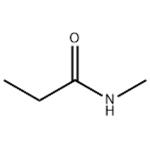Purification Methods
The amide is a colourless, odourless, neutral liquid at room temperature with a high dielectric constant. The amount of water present can be determined directly by Karl Fischer titration, GLC and NMR have been used to detect unreacted propionic acid. Commercial material of high quality is available, probably from the condensation of anhydrous methylamine with 50% excess of propionic acid. Rapid heating to 120-140o with stirring favours the reaction by removing water either directly or as the ternary xylene azeotrope. The quality of the distillate improves during the distillation. N-Methylpropionamide can be dried over CaO. Water and unreacted propionic acid are removed as their xylene azeotropes. It is then distilled in a vacuum. Material used as an electrolyte solvent (specific conductance less than 10-6 ohm-1 cm -1) is obtained by fractional distillation under reduced pressure, and storage over BaO or molecular sieves because it readily absorbs moisture from the atmosphere on prolonged storage. [Hoover Pure Appl Chem 37 581 1974, Recommended Methods for Purification of Solvents and Tests for Impurities, Coetzee Ed., Pergamon Press, 1982, Beilstein 4 IV 183.]




